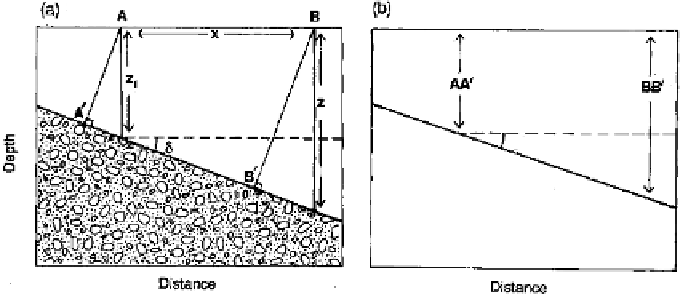Geoscience Reference
In-Depth Information
(a)
(b)
A
B
x
z
1
AA
BB'
z
A'
d
'
d
B'
Distance
Distance
Figure 4.47.
(a) Normal-incidence reflections from an interface with dip
δ
. With the
source and receiver at A, the reflection point is A' (likewise B and B'). The upper
layer has a P-wave velocity of
α
1
. (b) The record section for the structure in (a). On a
section with equal horizontal and vertical distance scales, the apparent dip
δ'
is less
than the real dip
δ
(Eq. (4.99)).
where
z
is the vertical depth of the reflector below B. The depths
z
1
and
z
, dip
angle
δ
and horizontal distance
x
between A and B are related by
z
−
z
1
x
tan
δ
=
(4.96)
Since the reflections from A
and B
plot on the record section as though they
were vertically beneath A and B, respectively, the reflector appears to have a dip
of
δ
,where
BB
−
AA
x
tan
δ
=
(4.97)
On substituting from Eqs. (4.92) and (4.94), this becomes
z
cos
δ
−
z
1
cos
δ
x
tan
δ
=
(4.98)
Further substitution from Eq. (4.96) yields
tan
δ
=
sin
δ
(4.99)
δ
is less than the actual dip
Thus, the apparent dip
δ
,except for very small angles,
for which the approximation sin
is valid. Reflection record sections are
rarely plotted at true scale: distortion is also caused by differing horizontal and
vertical scales as well as by the vertical axis frequently being two-way travel
time.
δ
≈
tan
δ
Migration
A dipping reflector is not the only structure which is incorrectly located on a CDP
record section. A reflection from any variation in structure in the third dimension,
conveniently assumed to be nonexistent here, could also appear on the section.











